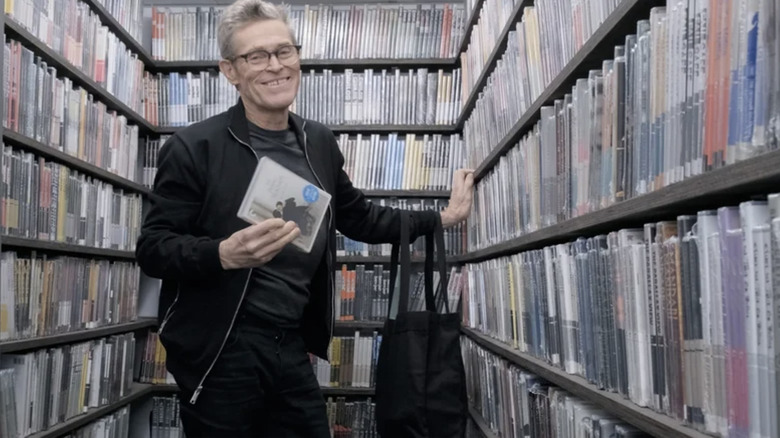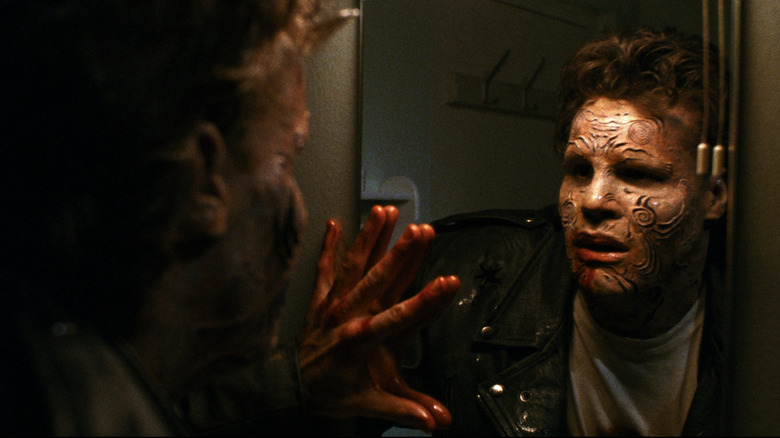In the wake of the legendary David Lynch’s passing, social media timelines flooded with tributes to the influential filmmaker, often utilizing screenshots and gifs from his immaculate body of work. However, another image made the rounds with just as much fervor — namely, that of Pamela Anderson in the hallowed grounds of the Criterion Closet with the subtitle “We love David Lynch.” Anderson had made her visit to the famed closet as part of the awards campaign for “The Last Showgirl,” a way for movie lovers to admire (or judge) her taste in cinema. (For the record, Anderson has great taste.) Indeed, countless creatives have made their way to the Criterion Closet since Guillermo del Toro was first filmed making his selections back in 2010, with many calling it a “dream come true.”
When Criterion announced that it would celebrate its 40th anniversary by replicating the Closet with a portable Closet van, cinephiles across the country started planning their visits when the tour reached their home cities. To have a movie in the Criterion Collection is a great honor. Still, there are a few misconceptions regarding what the Criterion Collection actually is, what purpose it serves in our culture, and how decisions are made regarding the films that “get in.” Coming from a physical media obsessive, consider this your crash-course history lesson and guide to all things Criterion.
What is the Criterion Collection?
Founded by Robert Stein, Aleen Stein, and Joe Medjuck in 1984, Criterion is a pioneering home media distribution company that focuses on restoring, preserving, and publishing important cinematic works — classic and contemporary — across all genres and from around the world. The films that Criterion distributes on physical media are considered part of the Criterion Collection, including its early days of LaserDisc and out-of-print DVDs. Criterion was truly the first of its kind to include restorations and supplemental special features to encourage repeat viewings with its releases, essentially providing buyers the ultimate viewing experience that included film enjoyment and film education. For over 40 years, Criterion has worked in tandem with filmmakers and film scholars to put out the best release possible of any given title.
As far as the films that are selected to be a part of the collection, despite the “arthouse” or “snobby” accusations often lobbied at Criterion, the collection has a little bit of everything. An intimate, black and white micro-budget queer film like “Go Fish” exists alongside an exercise in depravity like “Salò, or the 120 Days of Sodom,” Chantal Akerman’s French masterpiece “Jeanne Dielman, 23, quai du Commerce, 1080 Bruxelles,” and an explosive blockbuster like Michael Bay’s “Armageddon.” But Criterion doesn’t have carte blanche to obtain any title it wants, including films it’s previously released. Criterion is also at the mercy of the movie’s rightsholders. For example, Criterion released John Woo’s action classic “Hard Boiled” on DVD and it has been out of print for many years, but we likely won’t see a re-release anytime soon as Shout! Factory recently obtained the rights to 156 films in the Golden Princess Library of Hong Kong cinema, including “Hard Boiled.”
Why your favorite movie isn’t in the Criterion Collection
Movie lovers often confuse the Criterion Collection with the Library of Congress’ National Film Registry, the United States National Film Preservation Board’s collection of films selected for preservation selected for historical, cultural, and aesthetic contributions. Criterion is actually older than the National Film Registry, but whereas Criterion restores and preserves films from around the globe, the National Film Registry is solely dedicated to preserving American-made cinema without an arm for distribution. It’s also why “Star Wars: Episode IV — A New Hope” is in the National Film Registry, but is not (and likely will never be) in the Criterion Collection, despite the film’s cultural significance and undeniable influence on science-fiction cinema.
“Star Wars” is one of the golden geese of Lucasfilm, a subsidiary of Walt Disney Studios, a company notoriously protective of its titles. When “WALL-E” was added to the Criterion Collection in 2022, it was a massive deal because, as of publication, only nine films owned by Walt Disney Studios or one of its subsidiaries have been added to the Collection. So, if you’re wondering why your favorite movie isn’t in the Criterion Collection, it’s likely because either Criterion couldn’t obtain the rights, the filmmaker doesn’t want their film as part of the collection, or Criterion doesn’t feel the film is a fit.
Criterion still has a deep affinity for films even outside of their Collection, with the Criterion Channel streaming service frequently showcasing movies of questionable taste. Fun fact: last year, Johnny Knoxville was even celebrated by both Criterion and The Academy Museum of Motion Pictures when the Criterion Channel streamed the “Jackass” films, and the Academy’s John Waters exhibit had a section dedicated to “A Dirty Shame.” Neither title is officially part of the Criterion Collection, but that doesn’t make them any less important.
Other boutique labels worth celebrating
A film being a part of the Criterion Collection doesn’t immediately mean it’s “better” than another, and not being in the Criterion Collection doesn’t make a film lesser than. In fact, there are numerous boutique distribution labels also putting out impressive restorations packed with special features that may be the home of some of your favorite movies. Case in point: back in 2014, Scream Factory (the horror arm of Shout! Factory) was able to restore thought-to-be-lost footage of Clive Barker’s “Nightbreed” and put out the official director’s cut nearly a quarter of a century after the film first hit theaters. For horror fans everywhere, it was a chance for us to finally see the film as it was always meant to be experienced, and that wouldn’t have been possible without the tireless work of Scream Factory.
Vinegar Syndrome and its numerous sister labels like Mélusine and American Genre Film Archive (AGFA), have been equally invaluable in the preservation and rediscovery of exploitation, forgotten cinematic oddities, and vintage adult films that would have likely been lost to time if it weren’t for their archivists. Both “Looking for Mr. Goodbar” and “Little Darlings” nabbed VS releases last year, finally putting an end to their “hard to find” statuses. And there are so, so many other companies providing Criterion-level releases worthy of your time and money. Arrow, Severin films, Kino Lorber, Radiance, Umbrella, Synapse, Imprint, Eureka!, Diabolik, and even studio branches like the Warner Archives and Paramount Scares have helped keep physical media alive and ensured that all movies are given the same tender loving care as the Criterion Collection. There’s no such thing as an official cinematic canon and no one brand should be deemed the arbiter of quality.
Like what you like. Movies, now more than ever!











